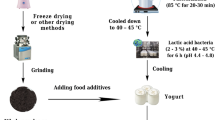Abstract
Lactic acid fermentation can have preservative effect on red beet juice. The behavior of the pigment in the fermented juice was investigated and the results were compared with those of non-fermented juice. Two red beet varieties (Czerwona Kula and Chrobry) were used in our experiment. Three probiotic bacteria and three infant intestinal microbiota of Lactobacillus sp. were selected for beet juice fermentation.
Lactic acid fermentation influenced both red and yellow pigments. In the two beetroot varieties (Chrobry and Czerwona Kula) studied, the dominant red-violet pigment components were betanin, isobetanin, while vulgaxanthin I was the major yellow pigment. Betanin was the main red-violet component in juices before fermentation. After fermentation also betanidin and isobetanidin were observed. Huge amounts of betanidin were found especially in fermented Chrobry juice.
It was observed that fermented juice from Chrobry cultivar contained higher betanidin than betanin levels. Contrarily, in juice from Czerwona Kula cv., betanin level was much higher than betanidin level.


Similar content being viewed by others
Abbreviations
- PA:
-
peak area
References
Borowska J (2003) Przem Ferm i Owoc-Warzyw (in Polish)
Kapadia GJ, Azuine MA, Sridhar R, Okuda Y, Tsuruta A, Ichiishi E, Mukainake T, Takasaki M, Konoshima T, Nishino H, Tokuda H (2003) Pharmacol Res 47:141–148
van Duyn MAS, Pivonka E (2000) J Am Diet Assoc 100:1511–1521
Vinson JA, Hao Y, Su X, Zubik L (1998) J Agric Food Chem 46:3630–3634
Kanner J, Harel S, Granit R (2001) J Agric Food Chem 49:5178–5185
Escribano J, Pedreno MA, Garcia-Carmona F, Munoz R (1998) Phytochem Anal 9(3):124–127
Braun-Młodecka (2004) Electron J Pol Agric Univ Hortic 7(1)
Klimek G (2003) Hasło Ogrodnicze 5 (in Polish)
Herbach KM, Stintzing FC, Carle R (2004) J Food Sci 69:491–498
Adams JP, von Elbe JH, Amundson CH (1976) J Food Sci 41:78.
Barath A, Halasz A, Nemeth E, Zalan Z (2004) Eur Food Res Technol 218:184–187
Klewicka E, Motyl I, Libudzisz Z (2004) Eur Food Res Technol 218:178–183
Lichtenthaler R, Marx F (2005) J Agric Food Chem 53:103–110
Nilsson T (1970) Lantbrukshoegsk Ann 36:179
Stintzing FC, Schieber A, Carle R (2002) J Agric Food Chem 50:2302–2307
Gardner NJ, Savard T, Obermeier P, Caldwell G, Champagne CP (2001) Int J Food Microbiol 64:261–275
Yamazaki S, Kaneko T, Takemoto N, Kano K, Ikeda Z (2002) Biosci Biotechnol Biochem 66:2100
Stintzing FC, Carle R (2004) Trends Food Sci Technol 15:19–38
Schwartz SJ, Hildenbrand BE, von Elbe JH (1981) J Food Sci 46:296–297
Kujala TS, Loponen JM, Klika KD, Pihlaja K (2000) J Agric Food Chem 48:5338–5342
Żuradzka E, Antos M, Pawłowska B (1996) VI Ogólnopolski Zjazd Hodowców Roślin Ogrodniczych “Hodowla roślin o podwyższonej jakości” Kraków, February 15–16, 160–164 (in Polish)
Sapers GM, Hornstein JS (1979) J Food Sci 44:1245–1248
Kujala T, Vienola MS, Klika KD, Loponen J, Pihlaja K (2002) Eur Food Res Technol 214:505–510
Cai Y, Sun M, Schliemann W, Corke H (2001) J Agric Food Chem 49:4429–4435
Schliemann W, Strack D (1998) Phytochemistry 49:585–588
Stintzing FC, Schieber A, Carle R (2000) Obst-, Gemuse und Kartoffelverarbeitung 85:196–204
Alard D, Wray V, Grotjahn L, Reznik H, Strack D (1985) Phytochemistry 24:2383–2385
Kujala T, Loponen J, Pihlaja K (2001) Z Naturforsch C J Biosci 56:343–348
Stintzing FC, Herbach KM, Mosshammer MR, Carle R, Yi W, Sellappan S, Akoh CC, Bunch R, Felker P (2005) J Agric Food Chem 53:442–451
Acknowledgments
This research is financially supported by the grant of the Polish Commission KBN. The results have been achieved in the frame of Polish project PBZ-KBN_094/P06/2003. The authors wish to thank Prof. Janusz Czapski for betanin standard and advice.
Author information
Authors and Affiliations
Corresponding author
Rights and permissions
About this article
Cite this article
Czyżowska, A., Klewicka, E. & Libudzisz, Z. The influence of lactic acid fermentation process of red beet juice on the stability of biologically active colorants. Eur Food Res Technol 223, 110–116 (2006). https://doi.org/10.1007/s00217-005-0159-y
Received:
Accepted:
Published:
Issue Date:
DOI: https://doi.org/10.1007/s00217-005-0159-y




